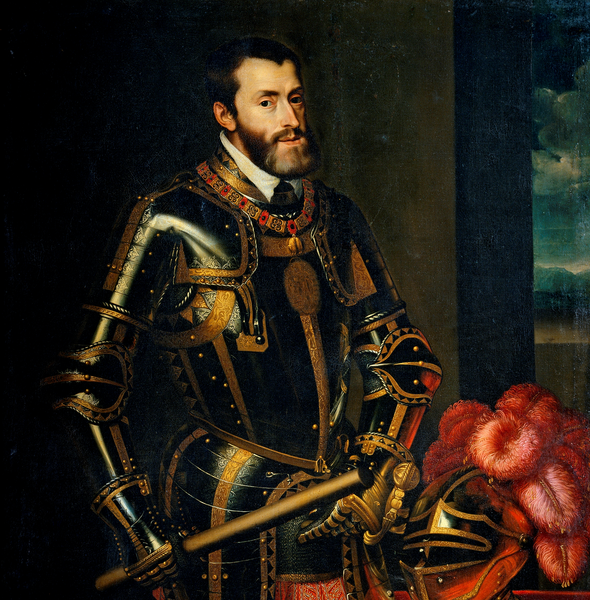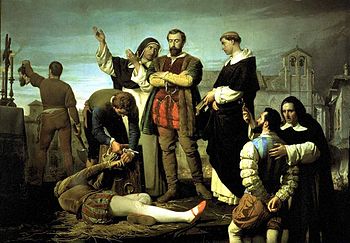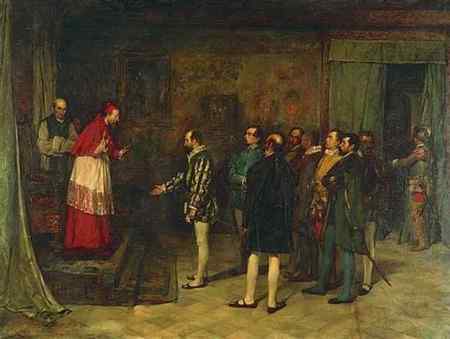At the beginning of the lesson Paqui has drawn us a Family Tree of the Catholic Monarchs. The Catholic Monarchs had 5 children and the names of their children were: Isabella, Joana, Mary, Catherine and John. Paqui also has explained us that the mortality was very high until the 19th century.
Then, we have copied a scheme about Charles I's reign. In this scheme we have spoken about the heritage of Charles I, the problems in the Peninsunla and the imperial policy.

Charles I was living in Ghent, and he didn´t arrive in the Peninsula until 1517. His grandfather Maximilian died, but his mother was alive. She couldn`t rule because she had mental problems, so Charles I was proclaimed king of Castile and Aragón. He had to respect some conditions. During his reign he had some internal problems. The most important revolts were the revolt of the Comuneros in Castile and the revolt of the Germanías in Valencia and Mallorca.
The revolt of the Comuneros started in 1520 and it finished in 1521. Many Castilian cities revolted against the King due to the new taxes they had to pay. The leaders of the revolt were Bravo, Padilla and Maldonado. Definitely they were defeated in the Battle of Villalar in 1521.

The execution of the leaders of the revolt (Bravo, Padilla and Maldonado)
Source: https://es.wikipedia.org/wiki/Juan_de_Padilla
The revolt of the Germanías in Valencia and Mallorca lasted from 1519 to 1521. It was a revolt of craftsmen and peasants who wanted to have access to the government in the municipalities and an improvement in the conditions of renting their lands.

Afterwards, Paqui has explained us the Imperial policy during Charles I's reign. Here they had objectives and problems. The objectives were to defend the empire and to defend the Catholicism, and the problems were several wars against France( Charles annexed Milan to the empire), against the Muslims(Charles occupied Tunis in 1523) and against the Protestants ( In 1555 the Peace of Augsburg was signed).
Finally, at the end of the class we have copied a scheme about Philip II's reign. The contents of this scheme were the heritage, the government and the objectives and the problems.
NEW vOCABULARY.
-Pope - Papa
-Barbary pirates - piratas berberiscos
-Renting conditions - condiciones de arrendamiento
-Crash - aplastar
-Wool - lana
-By force - por la fuerza
-Blackmail - sobornar
-Siege - sitiar
-Lift the siege - levantar el sitio
-Excommunicate - excomulgar
-Schmalkaldic league - liga de Esmalcalda
-Augsburg peace - paz de Augsburgo
-Atheist - ateo
BYEE!
Good job Andrei, but at the beginning of the journal I've seen a mistake. Paqui said that the infant mortality was high till the 19th century, not during, if not, it would be a totally mess!Hahaha.
ReplyDeletePlease, Andrei, you have to change Charles I 's picture for the right one (emperor Charles V) and write a title for your post: Monday, 21st September.
ReplyDeleteYou should also review the spelling of several words of the glossary: v ocabulary, crash, Esmacalda.
Bye!
I don't know how can I write the title for my posts,can you explain to me tomorrow? I've changed the picture of Charles I and I've corrected the wrong words. Bye!
ReplyDeleteHello again,
ReplyDeleteHere you have my corrections. Most of them are spelling mistakes. So I recommend you that next time you read again your journal before publishing, in order to avoid these mistakes. The corrections are highlighted in bold and the unnnecesary words or letters are in brackets (you have to erase them. REmember also that the names of religions or the believers/ non believers of a religion have to be written in capital letters (Atheist, Protestant...):
- At the beginning of the lesson Paqui has drawn us a Family Tree(s) of the Catholic Monarchs. The Catholic Monarchs had 5 children and the names of their children were: Isabella, Joana, Mary, Catherine and John. Paqui also has explained us that the mortality was very high until the 19th the century.
- Then, we have copied a scheme about Charles I's reign. In this scheme we have spoken about the heritage of Charles I, the problems in the Peninsula and the imperial policy.
- Charles I was living in Ghent, and he didn´t arrive in the Peninsula until 1517. His grandfather Maximilian died, but his mother was alive. She couldn`t rule because she had mental problems, so Charles I was proclaimed king of Castile and Aragón. He had to respect some conditions. During his reign he had some internal problems. The most important revolts were the revolt of the Comuneros in Castile and the revolt of the Germanías in Valencia and Mallorca.
- The revolt of the Comuneros started in 1520 and it finished in 1521. Many Castilian cities revolted against the King due to the new taxes they had to pay. The leaders of the revolt were Bravo, Padilla and Maldonado. Definitely they were defeated in the Battle of Villalar in 1521.
- Afterwards, Paqui has explained us the Imperial policy during (the) Charles I's reign. Here they had objectives and problems. The objectives were to defend the empire and to defend the Catholicism, and the problems were several wars against France (Charles annexed Milan to the empire), against the Muslims (Charles occupied Tunis in 1523) and against the Protestants ( In 1555 the Peace of Augsburg was signed).
- Finally, at the end of the class we have copied a scheme about Philip II's reign. The contents of this scheme were the heritage, the government and the objectives and the problems.
-Pope - Papa
-Barbary pirates - piratas berberiscos
-Schmalkaldic league - liga de Esmalcalda
-Augsburg peace - paz de Ausgburgo
-Atheist - ateo
That's all. Good work.
Paqui, I'll correct the mistakes.
ReplyDelete